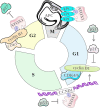Balancing between cuproplasia and copper-dependent cell death: molecular basis and clinical implications of ATOX1 in cancer
- PMID: 40721800
- PMCID: PMC12302472
- DOI: 10.1186/s13046-025-03486-5
Balancing between cuproplasia and copper-dependent cell death: molecular basis and clinical implications of ATOX1 in cancer
Abstract
Human antioxidant protein 1 (ATOX1) is an essential regulator of copper homeostasis in cells. By interacting with other proteins involved in controlling the intracellular levels of cuprous ions (Cu+), ATOX1 contributes to the import, export, and subcellular distribution of Cu+ as it functions within the CTR1-ATOX1-ATP7A/ATP7B axis. For this reason, ATOX1 plays a key role in preventing copper toxicity. Since copper ions have been shown to regulate the activity of a subset of other signaling proteins, ATOX1 can support cell proliferation, migration, and survival. Notably, ATOX1 is the only identified copper chaperone that has transcription factor activity. In this respect, CCND1, MDC1, NCF1, PPA2, and SOD3 have been experimentally validated as transcriptional targets of ATOX1 in distinct types of cells. The multifaceted actions of ATOX1 indicate that its dysregulation can lead to changes in the activity of crucial signaling pathways associated with diverse disorders, including cancer. Indeed, ATOX1 levels are frequently increased in cancer as demonstrated in multiple studies and supported by data available in GEPIA. ATOX1 has been implicated in cancer biology because of its role in the proliferation and metastatic spread of cancer cells and protection from oxidative stress. Additionally, ATOX1 may impact the drug response and resistance of cancer cells by influencing detoxification mechanisms as demonstrated for platinum-based therapies. In turn, the role of ATOX1 in the susceptibility of cancer cells to targeted therapies and immunotherapy remains elusive. This, however, should be a direction of further research considering the recent advances in understanding the complex role of copper in cancer cells, which can be associated with either protumorigenic effects (cuproplasia) or the induction of novel copper-dependent regulated cell death (cuproptosis) to combat cancer cells. Therefore, the disruption of ATOX1-mediated processes could be beneficial for the efficacy of anticancer therapies, although this possibility should be treated with caution because of the dual role of copper in cancer. Moreover, the prognostic value of ATOX1 expression for the clinical outcome of cancer patients needs to be clarified. In this review, we summarize the current state of knowledge about ATOX1 in cancer focusing on its molecular aspects and potential clinical implications.
Keywords: ATOX1; Cancer; Copper; Copper chaperone; Copper homeostasis; Cuproplasia; Cuproptosis; Oxidative stress.
© 2025. The Author(s).
Conflict of interest statement
Declarations. Ethics approval and consent to participate: Not applicable. Consent for publication: Not applicable. Competing interests: The authors declare no competing interests.
Figures




References
-
- Tsang T, Davis CI, Brady DC. Copper biology. Curr Biol. 2021;31(9):R421–7. - PubMed
-
- Pham AN, Xing GW, Miller CJ, Waite TD. Fenton-Like copper redox chemistry revisited: hydrogen peroxide and superoxide mediation of copper-Catalyzed oxidant production. J Catal. 2013;301:54–64.
Publication types
MeSH terms
Substances
Grants and funding
LinkOut - more resources
Full Text Sources
Medical
Research Materials
Miscellaneous

